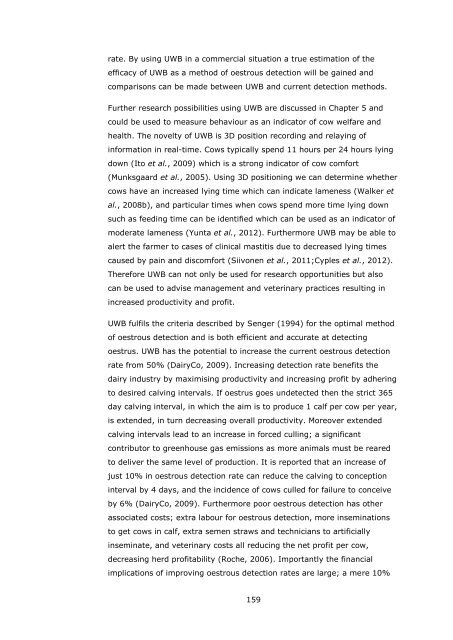novel approaches to expression and detection of oestrus in dairy cows
novel approaches to expression and detection of oestrus in dairy cows
novel approaches to expression and detection of oestrus in dairy cows
You also want an ePaper? Increase the reach of your titles
YUMPU automatically turns print PDFs into web optimized ePapers that Google loves.
ate. By us<strong>in</strong>g UWB <strong>in</strong> a commercial situation a true estimation <strong>of</strong> the<br />
efficacy <strong>of</strong> UWB as a method <strong>of</strong> oestrous <strong>detection</strong> will be ga<strong>in</strong>ed <strong>and</strong><br />
comparisons can be made between UWB <strong>and</strong> current <strong>detection</strong> methods.<br />
Further research possibilities us<strong>in</strong>g UWB are discussed <strong>in</strong> Chapter 5 <strong>and</strong><br />
could be used <strong>to</strong> measure behaviour as an <strong>in</strong>dica<strong>to</strong>r <strong>of</strong> cow welfare <strong>and</strong><br />
health. The <strong>novel</strong>ty <strong>of</strong> UWB is 3D position record<strong>in</strong>g <strong>and</strong> relay<strong>in</strong>g <strong>of</strong><br />
<strong>in</strong>formation <strong>in</strong> real-time. Cows typically spend 11 hours per 24 hours ly<strong>in</strong>g<br />
down (I<strong>to</strong> et al., 2009) which is a strong <strong>in</strong>dica<strong>to</strong>r <strong>of</strong> cow comfort<br />
(Munksgaard et al., 2005). Us<strong>in</strong>g 3D position<strong>in</strong>g we can determ<strong>in</strong>e whether<br />
<strong>cows</strong> have an <strong>in</strong>creased ly<strong>in</strong>g time which can <strong>in</strong>dicate lameness (Walker et<br />
al., 2008b), <strong>and</strong> particular times when <strong>cows</strong> spend more time ly<strong>in</strong>g down<br />
such as feed<strong>in</strong>g time can be identified which can be used as an <strong>in</strong>dica<strong>to</strong>r <strong>of</strong><br />
moderate lameness (Yunta et al., 2012). Furthermore UWB may be able <strong>to</strong><br />
alert the farmer <strong>to</strong> cases <strong>of</strong> cl<strong>in</strong>ical mastitis due <strong>to</strong> decreased ly<strong>in</strong>g times<br />
caused by pa<strong>in</strong> <strong>and</strong> discomfort (Siivonen et al., 2011;Cyples et al., 2012).<br />
Therefore UWB can not only be used for research opportunities but also<br />
can be used <strong>to</strong> advise management <strong>and</strong> veter<strong>in</strong>ary practices result<strong>in</strong>g <strong>in</strong><br />
<strong>in</strong>creased productivity <strong>and</strong> pr<strong>of</strong>it.<br />
UWB fulfils the criteria described by Senger (1994) for the optimal method<br />
<strong>of</strong> oestrous <strong>detection</strong> <strong>and</strong> is both efficient <strong>and</strong> accurate at detect<strong>in</strong>g<br />
<strong>oestrus</strong>. UWB has the potential <strong>to</strong> <strong>in</strong>crease the current oestrous <strong>detection</strong><br />
rate from 50% (DairyCo, 2009). Increas<strong>in</strong>g <strong>detection</strong> rate benefits the<br />
<strong>dairy</strong> <strong>in</strong>dustry by maximis<strong>in</strong>g productivity <strong>and</strong> <strong>in</strong>creas<strong>in</strong>g pr<strong>of</strong>it by adher<strong>in</strong>g<br />
<strong>to</strong> desired calv<strong>in</strong>g <strong>in</strong>tervals. If <strong>oestrus</strong> goes undetected then the strict 365<br />
day calv<strong>in</strong>g <strong>in</strong>terval, <strong>in</strong> which the aim is <strong>to</strong> produce 1 calf per cow per year,<br />
is extended, <strong>in</strong> turn decreas<strong>in</strong>g overall productivity. Moreover extended<br />
calv<strong>in</strong>g <strong>in</strong>tervals lead <strong>to</strong> an <strong>in</strong>crease <strong>in</strong> forced cull<strong>in</strong>g; a significant<br />
contribu<strong>to</strong>r <strong>to</strong> greenhouse gas emissions as more animals must be reared<br />
<strong>to</strong> deliver the same level <strong>of</strong> production. It is reported that an <strong>in</strong>crease <strong>of</strong><br />
just 10% <strong>in</strong> oestrous <strong>detection</strong> rate can reduce the calv<strong>in</strong>g <strong>to</strong> conception<br />
<strong>in</strong>terval by 4 days, <strong>and</strong> the <strong>in</strong>cidence <strong>of</strong> <strong>cows</strong> culled for failure <strong>to</strong> conceive<br />
by 6% (DairyCo, 2009). Furthermore poor oestrous <strong>detection</strong> has other<br />
associated costs; extra labour for oestrous <strong>detection</strong>, more <strong>in</strong>sem<strong>in</strong>ations<br />
<strong>to</strong> get <strong>cows</strong> <strong>in</strong> calf, extra semen straws <strong>and</strong> technicians <strong>to</strong> artificially<br />
<strong>in</strong>sem<strong>in</strong>ate, <strong>and</strong> veter<strong>in</strong>ary costs all reduc<strong>in</strong>g the net pr<strong>of</strong>it per cow,<br />
decreas<strong>in</strong>g herd pr<strong>of</strong>itability (Roche, 2006). Importantly the f<strong>in</strong>ancial<br />
implications <strong>of</strong> improv<strong>in</strong>g oestrous <strong>detection</strong> rates are large; a mere 10%<br />
159
















